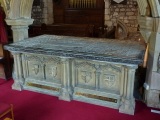Let’s Drink to That!
 Thanks to Karen Clark I read recently a note about “King Henry VI English Spring Water”. To be honest at first I thought that it might be a belated April Fools’ joke, but it seems to be for real.
Thanks to Karen Clark I read recently a note about “King Henry VI English Spring Water”. To be honest at first I thought that it might be a belated April Fools’ joke, but it seems to be for real.
After the loss of the Battle of Hexham on 15 August 1464 the Lancastrian king Henry VI stayed in hiding for several months with Sir Ralph Pudsey, a Lancastrian supporter, at Bolton Hall. This is in Bolton-by-Bowland in Lancashire, not far from Skipton, the home of another Lancastrian family, the Clifford (see here). There is a memorial to Sir Ralph Pudsey in the local church, which also includes his three wives and twenty five children.
Henry stayed for about a year, before being captured near Clitheroe, just down the road. On his departure he left behind a pair of boots, a pair of gloves and a spoon. However, he also left his name to a well, which according to local legend he ordered to “be dug and walled round for a bath”. This well “is much venerated by the country people to this day, who fancy that many remarkable cures have been wrought there”.[Roby, p.585]
The well is now a Scheduled Ancient Monument. There is a bath-shaped receptacle built into the floor which should be the bath, mentioned in the text above, but the water was probably also used for drinking. According to one source is smells of sulphur and is said to increase fertility – it seems to have worked for Sir Ralph, though was less effectual for Henry.
 The Tomb of Sir Ralph Pudsay, St Peter and St Paul’s Church, Bolton-by-Bowland (© Copyright Alexander P Kapp and licensed for reuse under this Creative Commons Licence)
The Tomb of Sir Ralph Pudsay, St Peter and St Paul’s Church, Bolton-by-Bowland (© Copyright Alexander P Kapp and licensed for reuse under this Creative Commons Licence)
Unfortunately Bolton Hall was demolished in the 1950s, the site is now occupied by a private development, called King Henry’s Mews, which is not open to the public, but the well can be seen from a public footpath near by.
Now, more than 500 years later, the natural spring water is being bottled by the Bosonnet family. Tests have shown that the water has significant mineral qualities. The bore hole has been dug to a depth of 47 m to extract the water, which is then piped underground to the bottling facility.
The company’s environmental efforts are impressive. The land around the well is in the process of organic accreditation, so that any pollution with undesirable chemicals should be avoided. The company is trying to minimise its impact on the environment, using eco-friendly methods and materials, as well as an extraordinarily high degree of insulation in its facilities. The use of an ozone generator in the plant gives chemical-free cleansing for bottle sterilizing, flushing pipes and washing down production areas. This means that all waste water can be returned straight to the surrounding natural water courses.
Buckingham Palace has allowed the company to use the King’s name on its products. The water comes both as still and sparkling water and is sold in clear glass bottles.
We wish the enterprise all possible success, even if Yorkist water – rather than this Lancastrian variety – would be more to my taste.
Bibliography:
King Henry VI Premium English Spring Water, accessed 7 Sept 2010
“King Henry VI English Spring Water”, Food & Drink News, accessed 7 Sept 2010
Keith Brunskill, “History and stories of Bolton-by-Bowland”, Bolton-by-Bowland, accessed 7 Sept 2010
John Roby, Traditions of Lancashire, Volume I. BiblioLife, 2009. ISBN-13: 978-0559124501 (originally published in 1829)
Bolton Hall, accessed 7 Sept 2010

Leave a reply